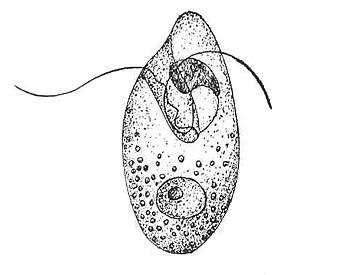Dinokaryon
A dinokaryon is a eukaryotic nucleus present in dinoflagellates in which the chromosomes are fibrillar in appearance (i.e. with unmasked DNA fibrils) and are more or less continuously condensed.

Nucleus with a dark nucleolus. The cell usually measures between 20 and 30 micrometers.
The nuclear envelope does not break down during mitosis, which is thus termed closed mitosis. The mitotic spindle is extranuclear.
Histones are absent.[1] However, recent EST sequencing has revealed the presence of histones in one of the closest relative to dinoflagellates, Perkinsus marinus and an early-branching dinoflagellate, Hematodinium sp.[2]
References
- FENSOME R.A., TAYLOR F.J.R., NORRIS G., SARJEANT W.A.S., WHARTON D.I. & WILLIAMS G.L. 1993. A classification of living and fossil dinoflagellates. American Museum of Natural History, Micropaleontology, Special Publication 7: 1-351.
- Gornik, S.G., Ford, K.L., Mulhern, T.D., Bacic, A., McFadden, G.I., and Waller, R.F.(2012). Loss of nucleosomal DNA condensation coincides with appearance of a novel nuclear protein in dinoflagellates. Curr. Biol. 22, 2303–2312
This article is issued from
Wikipedia.
The text is licensed under Creative
Commons - Attribution - Sharealike.
Additional terms may apply for the media files.